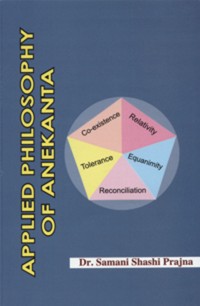Communication means to exchange thoughts in an effective manner. Communication is a part and parcel of our day-to-day world affairs. Communicating with people is an art and should be learned. For this, language acts as a bridge in expressing ourselves and understanding the feelings and emotions of others. Present age is the age of mass communication. It is the words, which come in purified form through anekāntic language of expression and makes one man nearer to the other and maintains healthy relations. The way in which one thinks is the way in which one speaks. Jaina ethics draw no real distinction between thought, speech, and action. In a chain reaction, violent thoughts and violent speech lead to violent acts.[1] So anekānta is nothing but the art of positive thinking. To maintain peace, the way your thoughts are communicated and the way they are understood should be in parity. In Daśvaikālika Sūtra, it is cited that the language which we use for communication should be filtered through some basic non-violent disciplines. It is highlighted in it that anger, greed, fear and laughter, are the four factors that are responsible for violent communication.[2] Lord Mahāvīra reflected upon the usage of non-violent language. He said, although true, few facts should not be disclosed.[3] Draupadi uttered clearly that the son of the blind is also blind, this small although true sentence culminated in the great war of Mahābhārata. Moreover one should not address someone as one eyed, impotent, sick and thief even if he is truly so.[4] So the language that is harsh and cause sinful activity should be avoided.[5] Marshall in his book, "Non-violent Communication", says one should not blame others for ones inauspicious communication.[6] A man of anekāntic approach utters each and every word cautiously and never blames others for his present situation. Our conversation should be peaceful and non-violent. Never attack directly with words. Never say something that can cause adverse reactions. In political field, the politicians mutually face verbal criticisms, which awaken the communal riots. In society, family disputes, social commotion, international wars and so forth are the outcome of insistence on one’s own words. Anekāntic technique of speech teaches; always use such non-violent words, which can make our human relations healthy. So there is close relationship between peaceful co-existence and non-violent communication.
Footnotes
Rankin Aidan and Atul K. Shah. Social Cohesion: A Jain Perspective. London: Diverse Ethics Ltd., 2008, p.37.
Rosenberg, Marshall B., Non-violent Communication: A Language of Life U.S.A.: Puddle Dancer Press. 2003, p. 123.
 Dr. Samani Shashi Pragya
Dr. Samani Shashi Pragya

